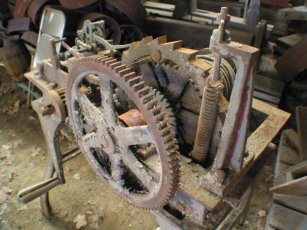
How it Works

|
The rusty Stevens striker |
Bells used by the US Light House Service for fog signals were not made exclusively for maritime use. They were cast at foundries throughout the United States and were also used for churches, town halls, and schoolhouses. In 1912, Meneely & Co of West Troy, New York cast the original bronze bell for Fiddler’s Reach. It weighed 1259 pounds and in 1914 was hung outside the tower from a 10” x 10” wooden beam projecting over the Kennebec River. During times of low visibility, the Lighthouse Keeper would walk about a quarter mile to the tower from the nearby residence along the shore and across a series of wood walkways to manually activate the bell. A clock tower mechanism, called a striker, sat inside the tower. It consisted of large iron gears, pulleys, heavy counterweights and a mechanical timer. The Keeper would crank the weight up to the top of the tower. The slowly descending weight powered a hammer to strike the bell twice every 20 seconds. After 4 hours, when the weight reached the bottom of the shaft (in our case a hole was cut in the floor to increase the duration), if the weather persisted, the Keeper would again crank it to the top. The bell was in continuous use at Fiddler’s Reach until an electric foghorn automated the function in the 1950s. The Coast Guard removed the bell in 1972. For many years it was displayed at the Coast Guard Academy in New London, Connecticut. The Range Light Keepers would like to install the original bell on the restored tower. Bath’s Maine Maritime Museum located a Steven's Fog Bell Striker mechanism, which is being restored by the Range Light Keepers to again ring the bell. It's a very interesting project that will involve the collaborative efforts of talented local artisans and engineers, organizations and businesses. We will be documenting our progress on this site.
|

